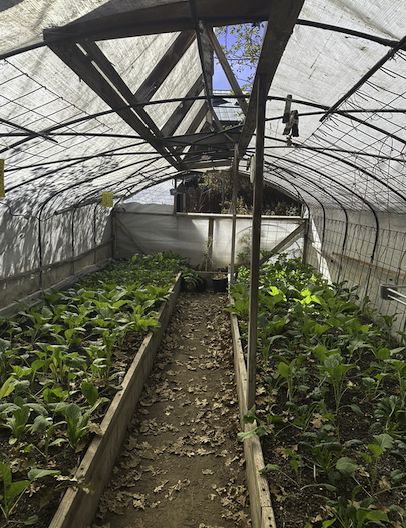Rosemary LoganCheckout the Spring 2020 section of NAU's two-semester Permaculture Design Course Blog! Archives
December 2023
Categories |
Back to Blog
Successful Growing in Arid Flagstaff12/7/2023 Northern Arizona poses a difficult environment for many growers to adjust to. We live at a high elevation with an arid ecosystem that has high chances of frost and extreme temperature change. So, it's no easy feat growing an abundant yield in this environment. This semester, we were able to see successful growers in Flagstaff and learn about their adaptive techniques for this harsh environment. Most notably, the Museum of Northern Arizona’s Colton Garden, provides a beautiful example of the potential of growing in cold and arid conditions. Here we observed many different growing methods, including permaculture techniques such as herb spirals, key-hole beds, mulching, and static composting. Colton garden exists on a larger scale though, compared to a new grower in Flagstaff with solely their backyard. Fritz, the resident gardener for Colton, uses her experienced knowledge to keep the garden thriving and mentor rotating interns who help maintain the garden. In the middle of the semester, we were able to meet two independent permaculturists, Greg and Patrick, who had some of the most highly productive and successful gardens we’ve seen in Flagstaff. From multiple composting techniques, to luscious greenery growing through winter. Greg even had strawberries growing in his garden in early November, something we have never witnessed before. Greg was most outwardly passionate, telling us about his varying compost techniques. He prides himself on having nutritious soil, something that can’t be achieved without a continuous flow of organic material. In Greg’s case, his compost. He had kitchen compost that was collected in an anaerobic bucket, so that the compost wouldn’t rot and stay warm before its use. He also had stack composting where he would layer different types of organic material, starting with wood chips, then food scraps, then coffee grounds, then whatever other material he could find such as hay and he would restart once the pile was low. This created a healthy aerated compost that he would then use as soil for his plants. He would sometimes use vermicomposting with this stacking compost. He would add worms such as red wigglers to break down the material, and attract other worms and small wildlife to continue this decomposition process. He would also inoculate his soil with mycelium to improve plant health as well as soil health. All of this work was to keep the soil productive and healthy during cold winter months so that the plants have a better chance of survival. Greg’s colorful and energetic personality made the afternoon more lively. Patrick and Greg could not have been more different with how they employed their permaculture techniques. While Greg utilized a more “free” and “wild” garden, with plants and pots strung throughout the yard with some, but little, strategic thought, Patrick placed his plants intricately (picture on right). Beds in the front yard included species that need additional sunlight and attention. The backyard held most other crops, some needing daily tending, but not all. His hoop house and small greenhouse were organized by plant species; Peppers with peppers, flowers with flowers, leafy greens all in one section. His knowledge and organization level was extensive. Patrick saves his seeds and keeps a collection of community-sourced native seeds. He writes and sends out an annual newsletter to other prospective gardeners. These are just a few examples of the lengths Patrick goes to in order to share his valuable ecological knowledge. The opportunity to see and explore some of the successful gardens in Flagstaff, Arizona provided valuable insight into overcoming the challenges of gardening in an arid, high-altitude environment. The Museum of Northern Arizona`s Colton Garden serves as a prominent example of permaculture in modern society by utilizing techniques such as mulching and static composting in large-scale community gardens, through the expert guidance of resident gardener Fritz. When meeting with independent permaculturists like Greg and Patrick, we were able to see the diverse and inspiring approaches to successful backyard gardening in Flagstaff’s environment. Greg's commitment to nutrient-rich soil, enhanced through his composting techniques, emphasized the essential maintenance of soil productivity during harsh winter conditions. In contrast, Patrick's permaculture strategy, which has much more meticulous organization and strategic plant placement within his garden, shows a high level of knowledge of companion planting. Along with this is his continued seed preservation and community engagement. The visual examples provided by Greg and Patrick's gardens, which captured flourishing plants and advanced cultivation practices throughout the warm and into the cold season, now serve as references for future gardening endeavors in Flagstaff’s demanding climate. All together, these gardens show us the importance of adaptability, knowledge-sharing, and creative problem-solving in cultivating thriving gardens amidst the arid and demanding conditions of Flagstaff. Mackenzie Schutte, Emma Dorch, Mallory Decker Permaculture: ENV/SUS 499
0 Comments
Read More
Leave a Reply. |
 RSS Feed
RSS Feed

